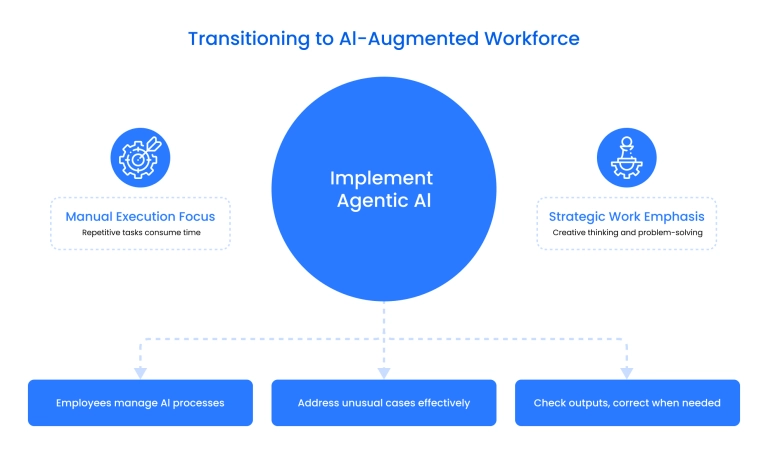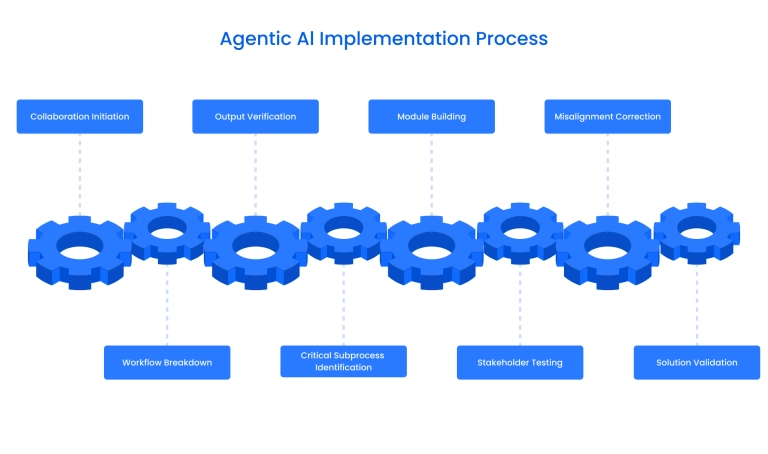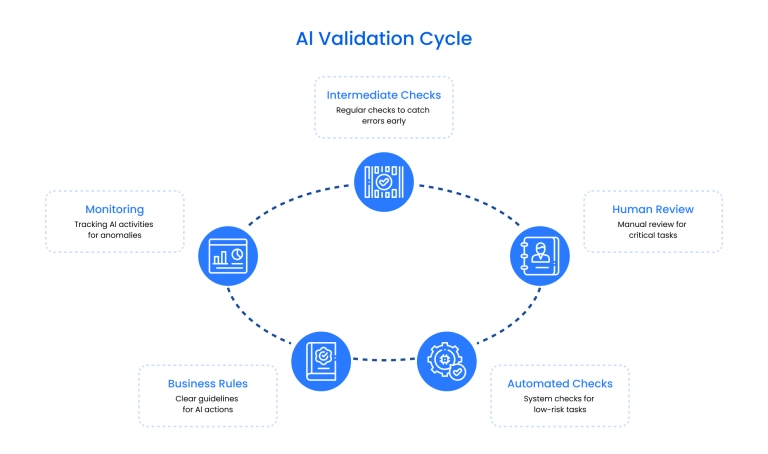Picture this: Your customer support tickets get automatically categorized, prioritized, and routed while the system learns your business rules and adapts in real-time. No human copying-pasting between systems, no missed edge cases, no "wait, which template do we use here?" This isn't sci-fi. We're building this for clients right now.
Most companies are still stuck thinking about AI as a fancy feature. But there's a bigger shift happening: agentic AI – intelligent systems that don't just suggest actions but actually take them, monitor results, and adjust course automatically.
What this looks like in practice
Consider an insurance or financial services company processing hundreds of loan applications daily. Their traditional workflow typically includes:
- Manual document validity and completeness checks
- Data entry across multiple systems
- Senior analyst review of every application
- Manual follow-up communications
With agentic AI implementation, the same process might look like:
- Automated document validation in seconds
- Synchronized data across all systems automatically
- Human review focused only on cases requiring judgment
- Automated personalized follow-ups with response tracking
*For deeper insights into implementing agentic workflows, explore our industry-specific articles for insurance , healthcare , and financial services companies.
Result:
Companies can see processing times reduced from days to hours, while analyst teams shift focus from administrative tasks to strategic work like risk modeling and process improvement.
These transformations aren't theoretical.
For example, we at Binariks have implemented agentic AI solutions for a hospital system that cut staff burden by 30% and an insurance company that achieved 90% reduction in time required to extract and analyze risk-related data from documents, plus 80-90% fewer manual review cycles, freeing analysts to focus on complex cases requiring human judgment.
This isn't about replacing people; it's about freeing them from repetitive work so they can focus on what humans do best: bring new ideas to your business and handle exceptions that require real judgment.
This creates what we call an orchestrated workforce, a blend of AI agents, automation tools, and people working together as one integrated team.
The AI handles high-volume, routine tasks at machine speed, while people oversee operations, review critical outputs, and step in when human judgment is needed.
This creates a powerful "x2-10 employee" effect – where AI augmentation enables existing workers to accomplish 2-10 times more work with significantly reduced time investment and cognitive overhead.
Such a balanced approach keeps organizations in control while unlocking the full potential of both human expertise and automation.
Smart features vs. AI agents
Most software today has AI features like autocomplete, recommendations, and chatbots.
Agentic AI is fundamentally different. Think of it as hiring a digital employee who can:
- Learn your specific business processes (not just generic templates)
- Make decisions within boundaries you set (following your rules, not generic algorithms)
- Coordinate between multiple tools and systems (like a human would)
- Adapt when something unexpected happens (without breaking or giving up)
Changing roles: From doing tasks to managing workflows
When we implement agentic AI for clients, job descriptions naturally evolve:
- Before: "Process invoices, update spreadsheets, send follow-up emails, generate reports"
- After: "Design invoice processing rules, monitor AI accuracy, handle exceptions, analyze patterns"
It's like going from being a cashier to being a store manager. Different skills, higher impact, and more strategic thinking are required.
The key insight?
People don't disappear – they level up.
Instead of executing every step manually, they become supervisors of intelligent workflows. They set the rules, monitor the outcomes, and step in when needed.
As AI learns from their decisions, it gradually handles more scenarios autonomously, creating a continuous feedback loop where human expertise trains increasingly capable and scalable automation . This evolution transforms workers from task executors into strategic orchestrators of intelligent systems.
However, this only works when employees understand how AI operates and where their oversight matters most. The best implementations we've seen treat this as a collaboration, not a replacement.

The edges of real business impact
Let's be specific about what "success" actually looks like:
- Speed: Decreased time to market: work for what matters
- Accuracy: Fewer errors from manual data entry and repetitive tasks
- Productivity: Greater output through AI-powered workflows without hiring 10x more people
- Employee satisfaction: More time spent on interesting stuff and less time on mind-numbing repetition, leading to less staff turnover
But here's what we've learned matters most:
The companies that win aren't the ones with the fanciest AI. They're the ones that figure out the right balance between automation and human oversight.
Your competitors are probably still debating whether business is ready for AI. While they debate, you could be building your first AI agent.
Why success depends on true partnership
Agentic AI implementation isn't a technology project but a co-creation effort combining deep business knowledge with technical expertise.
Here's what most companies miss: successful implementation starts before any code gets written.
At Binariks AI Center of Excellence, we've learned that AI readiness level, organizational awareness, data maturity, and business alignment, determines whether a project will thrive or join the pile of failed AI initiatives.
Companies typically fall into one of four readiness stages:
- Initial awareness level
There is an understanding of AI's potential benefits but also uncertainty over where to start.
The company may lack a clear vision of what business processes need improvement or an understanding that current problems can be solved using AI. It may also be experimenting with small-scale projects, usually isolated to specific use cases.
- Exploration/Experimentation level
The organization plans to integrate AI into specific processes or has already begun experimenting with Al through small-scale projects, yet may still lack a clear vision of where and how AI/ML might be most effectively applied.
Cherry-picking, or the selective extraction of data and identifying its value, is required to proceed.
- Integration level
The organization begins integrating Al solutions into their operations and knows what it desires to achieve with this tool and in what areas.
There's a question of building or enhancing data engineering pipelines, deploying Al/ML models into production, and integrating them into existing systems.
- Strategic optimization/Innovation level
The company has already adopted AI/ML, and this technology drives its strategy. However, specific cases may require tailored models and performance optimization.
Also, it is necessary to ensure that AI solutions are fully integrated with existing IT infrastructure and business processes.
Understanding exactly where you are prevents costly missteps and ensures the implementation approach matches your capabilities.
The process starts with business analysts and process owners working together to break workflows into smaller, clearly defined modules. Each module must produce an output that can be tested and validated independently. This modular approach – splitting complex workflows into verifiable pieces – creates the foundation for reliable automation.
Here's the critical part:
Not every step needs the same level of oversight. Revenue-impacting decisions might require human approval every time, while data formatting tasks might only need spot-checks. The client team and technical experts jointly determine where these checkpoints belong, ensuring oversight focuses where it truly matters.
Each module gets built and tested individually. Stakeholders validate that it works as expected before moving to the next piece. This catches misalignments early, before they become expensive problems. The result? An end-to-end solution that actually serves business goals.

Top 3 implementation traps
1. The "Automate everything" trap
- What happens: Teams try to automate their entire process on day one.
- Why it fails: Complex workflows have too many edge cases and dependencies.
- Better approach: Start with one clearly defined workflow that has predictable inputs and outputs.
2. The "Set it and forget it" trap
- What happens: Once the AI is working, teams assume it will always work perfectly.
- Why it fails: Business processes change, new edge cases emerge, external systems update.
- Better approach: Build in regular human checkpoints and monitoring from the start.
3. The "AI will figure it out" trap
- What happens: Teams expect the AI to learn their business rules through osmosis.
- Why it fails: AI agents need explicit rules and clear boundaries to make good decisions.
- Better approach: Spend time upfront defining exactly how decisions should be made.
How to build trust into the system
One of the biggest risks with advanced automation is that if one part produces the wrong result, the error can spread through the whole process.
Think of an AI agent as a skilled new team member from a related field – they have competence and potential but lack a deep understanding of your specific business domain. They know the technical methods, but need guidance on your company's unique processes, priorities, and edge cases.
Just as you'd pair such a specialist with an experienced employee who understands the business context, AI systems need human oversight to navigate domain-specific nuances and make contextually appropriate decisions.
Thus, instead of waiting until the very end to check results, necessary steps include intermediate checks. If something doesn't look right, the workflow can pause so a human can review it, or the system can stop that data from moving forward. This prevents minor issues from growing into significant failures.
Effective implementations typically design different oversight levels based on risk and impact:
| Risk Level | How AI Agents Can Help | Tasks Examples |
| Low-risk tasks | Agent handles automatically | Data formatting, routine data entry, standard email responses |
| Medium-risk tasks | Agent suggests, human approves | Customer service responses, document routing, report generation |
| High-risk tasks | A built-in human approval step is required. Human decides, and the agent provides data | Contract terms, pricing decisions, policy exceptions |
This clear division means people stay focused on areas where their time makes the biggest difference.
Over time, as confidence in the system grows, some checks may be relaxed to unlock even more speed, but always with the option to pause or adjust if something unexpected happens.

Additional safeguards commonly include:
- Limits on what the AI agent can do
- Minimum quality thresholds AI must meet
- Real-time monitoring dashboards
- Automatic alerts for unusual patterns
- Easy rollback options when needed
- Clear audit trails for all agent actions
Building your orchestrated workforce: Where to start
Agentic AI transforms the entire nature of work, rather than simply automating tasks. Done right, it creates an environment where AI agents and people bring out the best in each other, building what we call an orchestrated workforce.
The best place to begin is with a workflow that's:
- High volume: Lots of similar tasks following predictable patterns
- Clear rules: You can explain the decision-making process step-by-step
- Measurable outcomes: You'll know quickly if it's working or not
- Reversible: Low risk if something goes wrong initially
AI success comes from careful design, clear safeguards, and a strong partnership between business and technical teams. Teams gain speed and accuracy while maintaining full control over outcomes. With the right balance of automation and human oversight, companies transform agentic AI from a buzzword into a competitive advantage.
What's one workflow in your business that still requires too much manual work?
That's probably your starting point.
The future belongs to companies that can orchestrate human expertise with AI capabilities. The question is not whether this technology is ready but whether you are prepared to start building with it.
Ready to explore how agentic AI could transform your operations?
At Binariks, our AI Center of Excellence helps companies navigate from initial assessment to full implementation. We've guided organizations through every stage of AI readiness, from first experiments to strategic optimization.
Let's discuss your specific use case and map out a pathway that fits your business reality.
Share

